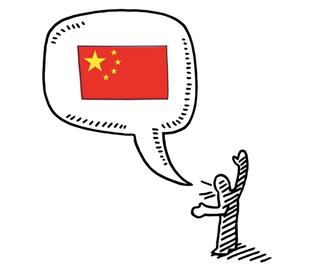The United States Studies Centre’s new debate series, "The Debate Papers", provides a platform for learned voices to argue issues affecting the United States, Australia, and the relationship between the two. These counterpoints traverse topics such as economics, foreign policy and politics. If you’d like to contribute to the series, email brendan.thomas-noone@sydney.edu.au or jared.mondschein@sydney.edu.au.
The case for China
James Laurenceson
Ask the average Australian whether China or the United States is Australia’s most important economic partner and you’ll likely get a bewildered look – it’s China, of course.
By 2013, 76 per cent of Australians were already convinced that China was number one, compared with just 16 per cent choosing the United States.[1] Public opinion reflects China’s enormous contribution to Australia’s trade and higher incomes. In 2011, then Governor of the Reserve Bank of Australia (RBA), Glenn Stevens remarked:
The proverbial pet-shop galah can by now recite the facts on Australia’s trade with China and our terms of trade, which are at a level not seen in over a century.[2]
The last time Australia had a bilateral trade relationship as significant as its one with China now was back in 1952-53 with the United Kingdom.[3] Such is the scale of trade that financial markets have long been of the view that the Australian dollar is one of the best proxies for bets on China itself.[4]
Such is the scale of the Australia-China trade relationship that financial markets have long been of the view that the Australian dollar is one of the best proxies for bets on China itself.
Over the past 12 months China snapped up Australian goods worth $95 billion, a record high, and eight times more than that bought by the United States.[5] Goods imported from China totalled $61 billion, more than double that from the United States. And what has become apparent more recently is China’s voracious demand for Australian services, worth $11.3 billion in 2016, although the United States continues to be a much bigger source of services imports.
The net result is that while the United States delivers Australia its largest bilateral trade deficit – $23 billion in 2016 – China is responsible for its largest surplus: $31 billion.[6] Most economists regard bilateral trade balances as inconsequential. But Chinese fondness for everything from Barossa Valley wine, sight-seeing on the Great Barrier Reef to studying at the University of Western Australia likely helps to explain why more Australians hold a favourable view of increased trade with China than the United States.[7]
Public perceptions around the value of the US economic relationship have further suffered from empirical evidence that Australia is worse off as a result of the Australia-US Free Trade Agreement.[8] Also not helping are the aggressive tax minimisation strategies pursued by some giant US multinationals,[9] along with the US government’s refusal to join Australia, China and 69 other countries in signing a new multilateral convention to close international tax loopholes.[10]
The fact that in the 2016 US presidential election campaign both Donald Trump and Hillary Clinton supported a withdrawal from the Trans-Pacific Pacific Partnership raised fresh doubts about whether the United States still shares Australia’s commitment to advancing multilateral rules-based trade. That the Trump administration now appears willing to use domestic legislation to pursue trade retaliation rather than the World Trade Organization’s dispute resolution mechanism only adds to these fears.[11]

Yet despite all this, some commentators conclude that the Australian public have it wrong. Niels Marquardt, the CEO of the American Chamber of Commerce in Australia (AmCham) has claimed:
No other nation looms as large as America when the total economic relationship with Australia is considered… Public opinion typically undervalues the critical role investment plays in creating prosperity and raising living standards.[12]
Australia’s Foreign Minister Julie Bishop has taken up this idea and constructed a metric of relative economic importance. If the stock of investment is added to flows of trade, then the United States comes out on top:
...the United States remains our single most important economic partner. When you combine two-way trade and investments, it stands at over $1 trillion.[13]
James Carouso, the chargé d’Affaires and the current head of the US Embassy in Australia has touted the same metric:
…the US is Australia’s leading economic partner; our bilateral economic engagement is at $1.9 trillion and growing.[14]
Researchers at US-focused think tanks in Australia such as the Perth USAsia Centre and the United States Studies Centre (USSC) have also been prominent in contesting the assessment that China is the undisputed number one.[15] Aside from the scale and technology benefits of American investment, another figure highlighted in a new USSC report is the sales of Australian companies in the United States:
Australia exports to the United States in 2016 were worth $US9.5 billion – a fraction of the $US60.6 billion that Australian-owned companies in the United States made in sales in the same timeframe.[16]
In other words, the sum of Australian exports to the United States and the sales of Australian companies in the United States stands at around $US70 billion. This is not far off the value of Australian exports to China.
Over the past 12 months China snapped up Australian goods worth $95 billion, a record high, and eight times more than that bought by the United States.
One motivation for pushing back against the view that China is Australia’s most important economic partner is provided by AmCham’s Niels Marquardt:
…a recent United States Studies Centre survey determined that Australians prefer increased trade with China more than increased trade with the United States. Our concern is that public perceptions such as these can lead to perverse impacts on policy formulation.[17]
Exactly what these perverse impacts might be is not clear. That the United States runs a massive trade surplus with Australia has already been noted. And on investment, Australia’s policies are indeed discriminatory but they are discriminatory in favour of the United States. For example, a privately-owned American company can buy parcels of agricultural land in Australia each worth up to $1.1 billion without ever needing the Commonwealth treasurer’s approval. For Chinese companies the approvals threshold is cumulative and set at a mere $15 million.[18]
Some also appear anxious that public opinion might influence Australian foreign policy in undesirable ways. Rory Medcalf, head of the National Security College at the Australian National University warns:
The risk is that Australians will buy the story that their economy is so comprehensively dependent on China that Australia cannot afford to cause China much difficulty on security and political issues, even when our interests diverge.[19]
The argument follows that if the general public could be persuaded the United States is Australia’s most important economic partner as well as its security ally, then the political environment for pushing back against those advocating for a foreign policy that exercises “greater independence within or at times without the alliance”[20] would become easier.
But some of the metrics used to elevate the status of Australia’s economic relationship with the United States struggle for rigour.
The last time the United States outperformed China on combined trade and investment flows with Australia was back in 2011.
Yes, the stock of two-way investment between the United States and Australia now stands at just shy of $1.5 trillion.[21] But this is a sum that has taken many decades to accumulate. Accordingly, it can hardly be compared to flows of trade that occur in a single year. Australian National University economist Shiro Armstrong points to a more sensible measure of relative economic importance:
The correct way to construct a measure that included investment would be to add investment flows to trade flows as well as to take into account the whole range of other economic interdependencies (like migration) in gauging a partner’s economic importance.[22]
In 2016, trade and investment flows with China stood at $178 billion. Those with the United States were not only less than with China, they were less than zero: -$27 billion. As usual, trade with China last year towered above that with the United States. But American investors also pulled $66 billion more out of Australia than they put in, while Australian investors dialled back their US asset holdings by $25 billion.
The last time the United States outperformed China on combined trade and investment flows with Australia was back in 2011.
And while the sales of Australian companies in the United States might sound similar to Australian exports to the United States, their impacts are very different. Australian companies in the United States employ American workers and pay taxes to the US government. The benefits to Australia are limited to the flow of any repatriated profits and dividends, a small fraction of their $US60.6 billion in US sales. In contrast, the $106 billion that China pays for Australian goods and services feeds directly into the pockets of Australian households, as well as the coffers of state and federal governments.
We could replace one but not the other
Another key distinction between the two economic relationships is that there are often substitutes for US investment but not Chinese demand.
Many of Australia’s biggest corporations regularly head to New York to raise capital. But London, Brussels, Tokyo, Hong Kong and Singapore would all welcome increased Australian business. The liquidity and breadth of US financial markets may make them the most convenient option. But that is very different to them being indispensable.
The idea that US direct investment is indispensable is also dubious. True, the US stock of direct investment in Australia now stands at $195 billion. But that compares with a total net capital stock in Australia of $5.5 trillion.[23]
Last year, US fund manager Global Infrastructure Partners took a 40 per cent stake in the Port of Melbourne. But half of its contribution was actually sourced from China’s sovereign wealth fund, China Investment Corporation.
Last year, in one prominent case of American direct investment in Australia, US fund manager Global Infrastructure Partners took a 40 per cent stake in Australia’s busiest port, the Port of Melbourne. But half of its contribution was actually sourced from China’s sovereign wealth fund, China Investment Corporation.[24] And then there were the rival consortiums that included bidders from other countries that ultimately lost out.
Now consider the predicament if Chinese steel makers no longer needed Australian iron ore. There is no prospect of any other country, or even group of countries, stepping up and absorbing the 650 million tonnes that China currently does.[25] In 2014, then US Secretary of State Hillary Clinton cautioned Australia not to put all its eggs in the China basket. Then Communications Minister Malcolm Turnbull quipped:
I’m sure that we’d love to export vast quantities of iron ore to the United States but they’ve never shown any enthusiasm in buying them.[26]
Such scenarios across the Australian economy help to explain why one recent, independent economic modelling exercise reported the sobering finding that if China’s growth rate slowed from the targeted 6.5 per cent this year to less than 3 per cent, up to 500,000 Australian jobs could be lost.[27]
China is where the growth is
China is also Australia’s growth market. China’s ravenous appetite for Australia’s agriculture and services stems from its middle class, which Brookings Institute researcher Homi Kharas finds is on track to expand by an extraordinary 850 million between 2009 and 2030. In contrast, the North American and European middle classes are expected to be stagnant. In terms of global middle class spending, by 2030 China is forecast to account for 22 per cent, three times greater than the US share.[28] Former Australian Foreign Minister Bob Carr contends:
Nothing else on Canberra’s agenda – talk about innovation, relations with India or tax cuts for business – competes with that statistic for its potential impact on Australian living standards.[29]
And while there is a way to go, the investment landscape is similarly being transformed. The latest comprehensive survey data from Australian companies shows that over the last three years China has relegated the United States to second position both as a direct investment source and an investment destination.[30]
Pursuing Australia’s national interest means recognising, as the Australian public already does, that the country’s most important economic relationship is now with China.
Simon Jackman, CEO of the USSC, points to robust investment between Australia and the United States as stemming from a shared commitment to values such as liberal democracy.[31] This is part of the story. But the main reason why the stock of Chinese investment in Australia is not larger is because China’s financial opening is still in its early stages. China’s stock of assets abroad (minus reserve assets) stands at just 30 per cent of its GDP.[32] The respective figure in the United States is 125 per cent.[33] On outbound investment, when Australian companies are asked why they targeted the United States as their first overseas market, 85 per cent cite a “familiar culture/language”. Only 40 per cent said the same about China.[34] The solution here is to focus on building Australia’s “Asia capable leaders”.[35]
The growing economic weight of China and many of its neighbours is remaking the strategic balance of the Asia-Pacific region. Australia’s relationship with the United States will be a valuable asset for both countries in navigating these shifts. At the same time, Australian policymakers should be clear that some of the fiercest competition that our farmers, universities and hotels will face when seeking to sell to China will come from the United States. Other countries can also be counted upon to pursue a mostly pragmatic approach in their China relations. Australia is entitled to do likewise. And pursuing Australia’s national interest means recognising, as the Australian public already does, that the country’s most important economic relationship is now with China.
The case for the United States
Jared Mondschein
As its largest foreign investor, the largest destination of its foreign investment, its second-largest trading partner, and an unparalleled provider of the capital required to fuel its economy, no single country is a more important economic partner of Australia’s than the United States.

The importance and value of the US-Australia economic relationship, however, is not necessarily appreciated by many Australians. Many polls have shown that a majority of Australians view China, Australia’s largest trading partner, as our most important economic partner.
To be sure, annual trade with China amounted to nearly $150 billion in 2015-2016, more than twice the amount of trade with the United States ($69 billion), Australia’s second largest trading partner.[36] Australian investment ties have increased significantly in recent years; Australia remains the second largest recipient of Chinese direct investment since 2007.[37] There is also no doubt that China's thirst for natural resources helped Australia successfully avoid the worst of the global financial crisis. The dividends Australia has received from China’s rapid economic rise have truly been extraordinary.
Why then do Australian leaders, including its foreign minister, repeatedly refer to the United States as “Australia's most important economic partner”?[38]
The simple answer is while much is often made of Australia’s trade with China, trade is only one component of a broader economic picture. A total stock of two-way investment between the United States and Australia of A$1.47 trillion – a similar amount to Australia’s annual GDP of US$1.2 trillion – dwarfs Australia's other bilateral economic relationships. Australia has always been a heavy importer of foreign capital, and that capital is a crucial driver of employment, economic growth, and also the ability to export its goods and services. The crucial fact is that Australia’s investment partnership with the United States has facilitated its trade with China by providing the necessary capital and know-how for the production of goods and services.
A total stock of two-way investment between the United States and Australia of A$1.47 trillion dwarfs Australia's other bilateral economic relationships.
What does the Chinese economic relationship look like?
In the course of researching the US-Australian economic relationship, it becomes strikingly clear that US business attitudes towards China differ considerably from Australian business attitudes towards China. While many US firms have been at the forefront of lobbying against Chinese trade practices, Australian firms have often chided Canberra for its restrictions barring more expansive economic relations with China.
The most straightforward reason for this is that Australia’s economic relations with China are large but not very complex. While countless US firms have tried to enter the Chinese market and encountered a range of challenges – ranging from intellectual property theft to poor corporate governance – fewer Australian firms have made such attempts. Instead, Australia’s economic relationship with China consists of the simplest types of transactions, albeit sizeable ones.
Australia’s A$86 billion of exports to China in 2015-2016 is dominated by the extraction of natural resources – predominantly being iron ore, but also coal and gold. Services are a growing component of Australian exports to China, most of which is dominated by education and tourism. It is no surprise then that around 90 per cent of Australian merchandise exports to China are “primary” goods – simple items with little to no manufacturing or intellectual property, such as ores, gas, and unprocessed animal products.[39] This means that the Australian natural resources are extracted, minimally processed, and sent to China. There are few opportunities in this straightforward trade relationship for Australian expertise to be used or for innovation to occur. On the other hand, there are fewer opportunities for Australian businesses to be frustrated by China’s notorious intellectual property rights or corporate governances challenges.
Cumulative investment from China stands at A$87 billion, with A$42 billion being direct investment – defined as foreign ownership of 10 per cent or more of a company. While overall Chinese investment into Australia grew by nearly A$12 billion in 2016, direct investment increased by $5 billion – less than half of the A$12 billion that US direct investment grew in the same period.
While overall Chinese investment into Australia grew by nearly A$12 billion in 2016, direct investment increased by $5 billion – less than half of the A$12 billion that US direct investment grew in the same period.
While trade is ultimately an exchange of money for goods or services, foreign investment– particularly direct investment – often goes beyond such simple transactions. An important motive for governments seeking out foreign investment is that it often includes transfers of business strategies, technologies and resources. Yet few of China’s investments in Australia have such positive spillover effects, with more than a third of Chinese direct investment into Australia in 2017 being in the real estate market – a sector that doesn’t lend itself to innovation.[40]
China’s investment and trade relationship with Australia is transactional. There is considerable economic gain in the short term but there are few long term gains in productivity or innovation.
What does the US economic relationship look like?
The US-Australia bilateral economic relationship focuses heavily on the attributes that Australia’s government – as well as the governments of developed countries around the world – have sought to develop and promote: high-skills and innovative work in technology-rich sectors.
US trade with Australia emphasises highly technical work – with two of the top four Australian exports to the United States being aircraft or spacecraft parts and pharmaceutical products. The vast majority of Australian merchandise exports to the United States are “elaborately transformed manufactures” – trade nomenclature for materials that require sophisticated manufacturing, not merely the extraction of natural resources.[41] US imports into Australia include cars, aircraft and spacecraft parts, and medical equipment.
In investment, the US-Australia economic relationship means thousands of US subsidiaries or US facilities located throughout Australia, with more than 1,000 US companies annually earning or valued at more than US$25 million. With a cumulative stock of inward investment valued at $861 billion in 2016 – about 10 times China's cumulative investments in Australia – the wide array of US investments in Australia are directly responsible for more than 335,000 Australian jobs with average salaries of more than A$115,000, annual capital expenditures of more than A$10 billion, and annual research and development spending of A$1.5 billion.[42]
The knowledge and skills transfer that result from US investment into Australia are often described by business leaders in Australia as one of the most valuable benefits of the investment relationship with the United States because it enriches the competitiveness and level of skill available in the Australian economy.
This investment relationship is certainly not a one-way street. The United States has long been the single largest destination of outbound Australian investment, comprising more than a quarter of all Australian overseas investment. Total cumulative Australian investment in the United States is estimated to be $617 billion – more than seven times the $87 billion that Australia has invested in China. This means hundreds of Australian firms in the United States, with total assets of US$285 billion and annual sales of more than US$60 billion in 2014 – more than six times the US$9.5 billion that Australia exported to the United States in 2016.[43, 44] Major Australian firms, ranging from biotechnology companies like ResMed to property giants like Westfield Corporation, see the United States not just as a market responsible for more than half of their global revenues, but as a springboard to the world.
The overwhelming choice to invest in the United States is by no means happenstance: it reflects the deep and wide ties between US and Australian financial services sectors.
Beyond direct investment, US capital markets and cross border portfolio investment – defined as ownership stakes of less than 10 per cent but generally seen as stocks and bonds – are increasingly critical components Australia’s economy. While the stock and bond transactions that make up foreign portfolio investment are not perceived to have the "bricks and mortar" nation-building effect of FDI, their unique importance to Australia should not be underestimated.
For almost its entire post-1788 history, economic observers classify Australia as being relatively resource rich but capital poor. As the leading source of foreign portfolio investment – representing over a third of all foreign portfolio investment in Australia – the United States has been indispensable in helping Australia address these structural features of our economy, geography, and history. Exploiting Australia's mining resources requires massive capital expenditures, underscoring the importance of US-sourced portfolio investment.
Australians' superannuations, home mortgages, its bridges, tunnels, dams, and roads depend on access to US capital and markets. US financial markets – and access to them – drive liquidity in the Australian economy. Australian portfolio investment stands at A$379 billion, having grown by A$24 billion in 2016 alone – twice the amount of Australian’s cumulative portfolio investment in China.
Some have said that US capital markets are not particularly unique and that Australian’s investments in them could easily be made in other capital markets. While capital is increasingly mobile, the overwhelming choice to invest in the United States is by no means happenstance: it reflects the deep and wide ties between US and Australian financial services sectors.
Australian portfolio investment stands at A$379 billion, having grown by A$24 billion in 2016 alone – twice the amount of Australian’s cumulative portfolio investment in China.
There is no doubt that the total stock of this A$1.47 trillion investment relationship has taken many decades to accumulate. That fact is undeniable as the investment relationship dates back to World War II. According to David Uren’s 2015 book on foreign investment in Australia:
“…the Australian economy was swept into the task of supplying the US war machine in the Pacific. The US Lend-Lease program delivered the latest US plant and equipment to upgrade Australia’s manufacturing capability for delivering everything from bomber aircraft to radios, steel, ships, clothing and tinned chilli con carne. Production of canned vegetables went from 4,000 tons at the beginning of the war to 60,000 tons by the end … At the end of the war, a deal was cut under which Australia would pay the United States US$27 million for the Lend-Lease equipment it was leaving behind. The war left Australia with a much larger and more sophisticated manufacturing base…”[45]
This many decades-long narrative is significant not due to any mere historical reverence but because it is indicative of how Australia’s deep economic ties with the United States – particular in terms of long-term US investments – have a nation-building legacy that continues to grow Australia's stock of human capital and technological capacity.
Making a crude choice
Ultimately, a focus on bilateral economic ties omits the critical value chain that globalised economic ties have engendered. The United States has invested the capital and technology in Australia that has allowed it to export unprecedented levels of raw materials to China, where they are processed and then exported as goods back to the United States and Australia.
With that said, if forced to make the crude choice of deciding which economic ties are more important, the decision can be made clearest by engaging in a simple thought experiment of comparing just how impactful the loss of economic ties from either country would be on the Australian economy.
If the Chinese economy were to suddenly disappear, it would certainly be catastrophic for the Australian economy. As Australia’s largest trading partner, the loss of such a vital consumer of Australian resources would all but guarantee an economic depression, forcing Australia to re-tool its economy.
The loss of all economic ties with the United States is simply unimaginable. How could, for example, the Australian economy function without access to the products made by US technology companies?
The loss of all economic ties with the United States, on the other hand, is simply unimaginable. In a most tangible sense, the sheer number of US brands that a typical Australian encounters on a daily basis is practically immeasurable – how could, for example, the Australian economy function without access to the products made by US technology companies? The United States is so deeply intertwined in the Australian economy that it’s simply too difficult to fathom.
Some argue that China’s demand for Australian goods is unprecedented and irreplaceable by any other country. While there is no doubt that China’s direct contribution to Australia’s GDP is unmatched, Australia need only to look at its trading habits from 20 years ago to comprehend what its economy would look like without a voracious Chinese appetite for its natural resources.
Beyond numbers
Deep economic relationships between liberal, market-based societies like Australia and the United States are not merely about trade flows. Secure property rights, limits to state power, and procedural fairness – backed by the rule of law and democratic political institutions in both countries – mean that Australia's economic relationship with the United States spans access to capital, technological diffusion, and knowledge transfers. In each of these domains, the United States is Australia's most important partner.
While China is undoubtedly an economic behemoth with a rapidly increasing middle class, it is still a developing country with a lot of room to grow both economically, but also politically. Once China is able to transparently engage in overseas trade and investment without opaquely governed state-owned enterprises and controversial practices, then it is only a matter of time until the determination of Australia’s most important economic partner will not even be debateable.







